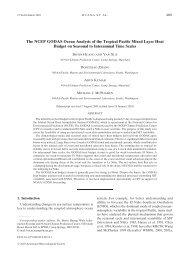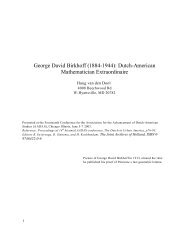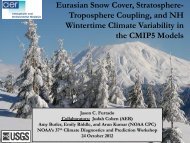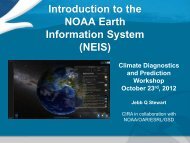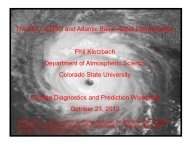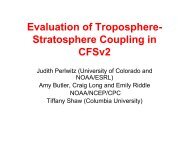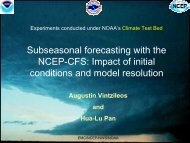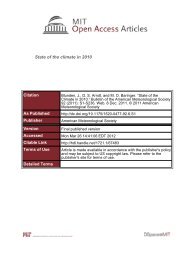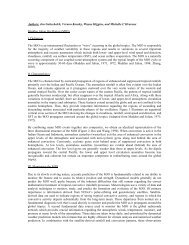Seasonality of the Pacific decadal oscillation - Climate Prediction ...
Seasonality of the Pacific decadal oscillation - Climate Prediction ...
Seasonality of the Pacific decadal oscillation - Climate Prediction ...
You also want an ePaper? Increase the reach of your titles
YUMPU automatically turns print PDFs into web optimized ePapers that Google loves.
2. Data<br />
Our analysis is based on data from observations and a coupled model simulation.<br />
As will be shown, <strong>the</strong> spatial pattern and seasonality <strong>of</strong> <strong>the</strong> PDO are similar between<br />
observations and <strong>the</strong> coupled model simulation. Use <strong>of</strong> <strong>the</strong> model simulation allows us to<br />
investigate <strong>the</strong> seasonality <strong>of</strong> <strong>the</strong> PDO based on a longer and more consistent oceanatmosphere<br />
model data set.<br />
The SST used in this study includes observational data from <strong>the</strong> National Oceanic<br />
and Atmospheric Administration (NOAA) Optimum Interpolation SST (OISST) V2<br />
(Reynolds et al. 2002), NOAA Extended Reconstructed SST (ERSST) V3b (Reynolds et<br />
al. 2007), and simulated data from <strong>the</strong> National Centers for Environmental <strong>Prediction</strong><br />
(NCEP) <strong>Climate</strong> Forecast System (CFS; Saha et al. 2006) coupled model. The OISST is<br />
on a 1 o × 1 o (latitude × longitude) grid and over 29 years from 1982 to 2010. The 29-yr<br />
period <strong>of</strong> <strong>the</strong> satellite observations may be too short to represent PDO. The ERSST, with<br />
a longer record is also employed, which is on a 2 o × 2 o (latitude × longitude) grid and<br />
over 150 years from 1861 to 2010. The SST from <strong>the</strong> CFS is on a 1 o × 2 o (latitude ×<br />
longitude) grid. The CFS was initialized with January 1, 1981 conditions obtained from<br />
<strong>the</strong> NCEP/Department <strong>of</strong> Energy (DOE) Reanalysis 2 (R2; Kanamitsu et al. 2002) for <strong>the</strong><br />
atmosphere and from <strong>the</strong> NCEP Global Ocean Data Assimilation System (GODAS;<br />
Behringer and Xue 2004) for <strong>the</strong> oceans. The coupled model was integrated for 500<br />
years. The last 480 years are used in <strong>the</strong> analysis. Data from <strong>the</strong> model simulation is<br />
divided into 16 segments <strong>of</strong> 30-yr periods. Each shorter-period segment is comparable<br />
with <strong>the</strong> 29 years in <strong>the</strong> OISST, and <strong>the</strong> analysis <strong>of</strong> PDO seasonality over 16 such<br />
4




